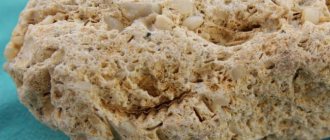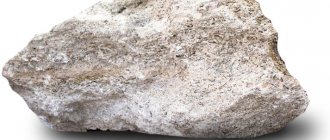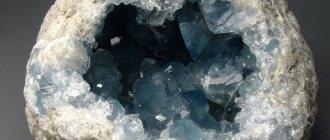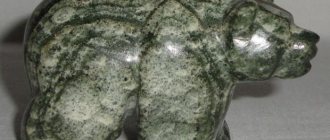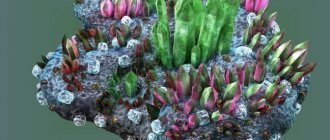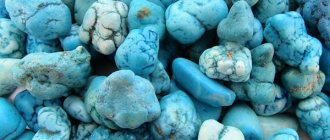Limestone composition
The chemical composition of pure limestones is close to calcite, where CaO is 56% and CO2 is 44%. Limestone in some cases includes admixtures of clay minerals, dolomite, quartz, less often gypsum, pyrite and organic residues, which determine the name of limestone. Dolomitized limestone contains from 4 to 17% MgO, marly limestone - from 6 to 21% SiO2 + R2O3. The sandy and silicified limestone contains admixtures of quartz, opal and chalcedony. It is customary to reflect in the name of limestone the predominant presence of organogenic remains (bryozoan, algal), or its structure (crystalline, clotty, detritus), or the shape of rock-forming particles (oolitic, brecciform).
Limestone
Details Category:
LIMESTONE , calcium carbonate, CaCO3, a very common sedimentary rock. Theoretical composition of limestone: 56% CaO and 44% CO2; as impurities in limestone there are: MgO, SiO2, Al2O3, iron oxides, MnO, P2O5, Na2O, K2O, V2O3, S, SO3, TiO2, Cl, H2S and other rarer elements. The content of magnesium salts in limestone ranges from 0 to 21.9%, and in the latter case the limestone turns into dolomite. Limestones containing MgO from 6 to 12% are called magnesian, with 12-18% - dolomitized; the presence of oxides of Al, Si and Fe, in the form of the finest clay impurities, transforms them into clayey limestone, or marl. When the content of clay particles is from 5 to 12%, limestone is called clayey, from 12 to 25% - marly, and over 25% - marl. Quite often there are limestones containing, in the form of mechanical impurities, grains of quartz and other rocks, being thus. sandy limestones; if SiO2 (the main sample in the form of opal) serves as cement, then such limestones are called siliceous. In ferruginous limestones, the high content of iron oxides gives the limestones a yellow, brown or red color. Some varieties of limestone contain glauconite, which gives them a green tint, or grains and nodules of phosphorites. Finally, quite often limestones contain organic matter (bitumens); Such bituminous limestones, gray or black in color, emit the smell of oil or hydrogen sulfide when struck; When fired, they lose their color and become white. Limestones with a bituminous content of more than 3% are called asphalt and are the initial product in the production of asphalt. This kind of bituminous limestone can also serve as excellent oil reservoirs, as, for example, in the newly discovered oil field in the Urals.
Limestones, for the most part, in their origin, belong to organogenic formations, divided into two groups: 1) zoogenic (remains of animal organisms) and 2) phytogenic (in the formation of which algae played a major role). The zoogenic group of limestones is represented in turn by the following varieties. a) Shell rocks - consist of shells of unequal preservation, and when the remains of certain organisms predominate over others, then in this case the limestones are given special names, such as: gastropod, fusuline, nummulitic, orthoceratite, etc. Shell limestones are divided into pure shell limestones (whole shells), detritus (angular fragments of shells) and detritus-sand (rounded fragments of shells). Depending on the cementing substance, shell rocks receive a variety of textures - from loose, weakly cemented to extremely dense and massive, b) Coral and bryozoan limestones - very dense, found in the form of separate massifs, remnants of bryozoan and coral reefs, c) Chalk (silty type of limestone) - consists of the remains of microorganisms: foraminifera, etc.
The next group, very different from organogenic in origin, is represented by oolitic limestones and tuffs. a) Oolitic limestones (pisolite, pea caviar stone) were formed by the precipitation of CaCO3 from saturated solutions (sediments of springs and shallow seas) or by the activity of bacteria releasing CaCO3 from solutions around some center (sand grains, shell fragments, etc.) in the form of concentric shells , balls. b) Calcareous tuffs and travertines are purely chemical sediments. They were formed from solutions containing Ca(HCO3)2. The texture of tuffs is foamy and porous.
Limestones after their formation b. parts recrystallize, giving a number of varieties, from which one can distinguish: a) semi-crystalline limestones, in which the main mass is partially recrystallized - such limestones are usually very dense, fossils are rare; b) marble-like limestones - no fossils are found, the entire mass is recrystallized, the rock is very dense and hard.
The specific gravity of limestone, depending on its composition, ranges from 2.6 to 2.9; pure varieties have a specific gravity of 2.70-2.72.
The industrial uses of limestone are very diverse. In the construction industry, hard and dense varieties, especially marble-like and semi-crystalline limestones, are used as facing materials, rubble for foundations, window sills, paving slabs and steps. Some test results carried out in the Mechanical Laboratory of the Institute of Railway Engineers are given below.
The main building material in the south of the USSR is tertiary limestone-shell rocks. The cities were built from them. Baku, Odessa, Sevastopol, Simferopol, Evpatoria, Feodosia, Kerch, Yalta, etc. This limestone can be easily sawed with a saw and takes well to hewing with an ax. There is no set standard for sawstone; for Crimea the adopted size is 240x200x500 mm; in Odessa, “pieces” of several sizes are cut: 1) five-piece (222x222x622 mm), 2) six-piece (267x267x712 mm), 3) butts (222x222x445 mm); in Baku - 2 types: 1) Gyusha (378x178x156 mm) and 2) dumagzy (712x267x x 199 mm).
Tests of limestone-shell rock for compressive strength at the Institute of Applied Mineralogy gave the following average results (in kg/cm2).
Southern shell rock gives a low thermal conductivity coefficient of 0.2-0.3 Cal m/m2 °C, i.e. approximately 2-3 times less than red brick. The practice of southern construction has shown that the cost of masonry made from this stone is 50-56% cheaper than brick masonry. In cement production, limestone is used in wide quantities. First of all, clayey limestones and marls, the so-called, are used for the production of cement. natural cements. In Portland cement production, limestone is mixed in a certain proportion with clay. In the metallurgical industry (especially ferrous industry), limestone is used as a flux in blast furnace, open-hearth and other processes; at the same time, limestones should be as free as possible from silicic acid and clay impurities. The beet sugar industry uses high-calcium limestones that do not contain SiO2 and clay impurities. The central development of limestone for sugar factories is concentrated in Ch. arr. on the right bank of Ukraine. In the main chemical industry, the use of limestone is also very diverse: 1) for the production of CO2, 2) in the soda process according to the Solvay and Leblanc method, 3) in the production of bleach (bleach) lime, 4) in calcium nitrate production (Norwegian nitrate), etc. In agriculture, limestone is used as one of the factors for increasing productivity.
Limestone deposits in the USSR. In the USSR, limestones are found from the most ancient Cambrian deposits to modern Quaternary ones. At the same time, the more ancient Silurian, Devonian and Carboniferous limestones are distinguished by their density, often dolomitized and often marble-like. In the Northern region of the RSFSR, limestones of Silurian and Carboniferous age are of greatest importance. Silurian limestones are mined in the Leningrad region. In Karelia, chapters are being developed. arr. Devonian and Carboniferous limestones; Permian and Carboniferous limestones are found in the Arkhangelsk province; Devonian ones are found along the shores of the White Sea. The development of Permian limestones in the Vyatka district is concentrated in Ch. arr. in the mining district (Omutninsky district). The limestone deposits of the Central region, thanks to the developed industry, are of exceptional importance. Limestones are very diverse in quality and belong to sediments of different ages. The Moscow basin is surrounded from the west and south by a ring of Devonian limestone outcrops; they are overlain by a series of the most valuable carboniferous limestones (Productus, Serpukhovian and Moscovian stages). In the central part, Carboniferous deposits are overlain by Jurassic and Cretaceous (poorer limestones). In the eastern part (Kostroma district, Nizhny Novgorod district and Tatar Autonomous Soviet Socialist Republic) limestones of Permian age are developed. In the Central Black Earth Region, in its northern part, Carboniferous limestones predominate, in the center - Devonian, in the eastern part - Ch. arr. Jurassic and Cretaceous. In the Tatar Autonomous Soviet Socialist Republic and the Chuvash Autonomous Soviet Socialist Republic, limestones of Permian age are mined, Ch. image of the Kazanian stage. In the Urals, limestone deposits are very numerous. They are located on both slopes of the ridge. In the central part of the ridge there are Devonian limestones in a meridional strip. On the western slope the strip is Carboniferous, and further to the west it is Permian in age. All developments ch. arr. confined to mining enterprises (for fluxes) or chemical plants. In the South-Eastern region (Volga region), the largest developments are confined to the Samarskaya Luka (on the Volga), where Carboniferous and Permian limestones emerge. On the territory of the Ukrainian SSR, limestone deposits are very common and belong to the most diverse formations in age - from Precambrian to modern deposits. Major developments, ch. arr. for the metal industry are concentrated in the Donbass. In Crimea, tertiary limestone-shell rocks are of great interest. In the North Caucasus region, the best material is limestone of the Upper Cretaceous to Jurassic ages. In Transcaucasia, the limestones of the Apsheron stage in the area of Baku are of greatest interest. In the Kazan Autonomous Soviet Socialist Republic, all developments are confined mainly to metallurgical plants; Marble-like limestones are being mined. Information about limestone deposits in the Siberian region is very scarce.
The extraction and consumption of limestone is difficult to account for, since all production is very dispersed. Limestone is a material consumed by ch. arr. on the spot. There are no exact figures for global production. In 1926, 127.8 million tons of limestone were mined in the USA, and 11 million tons in England.
According to the Geological Committee, the total production of limestone in the USSR was expressed (in tons):
The distribution of limestone by individual types of industry (for 1926/27) gives the following picture:
According to approximate data of the Geological Committee, the share of individual areas in limestone production for 1926/27 is expressed (as a percentage of total production) as follows:
Source: Martens. Technical encyclopedia. Volume 8 - 1929
- < Back
- Forward >
Description and types
Based on their structure, limestones are distinguished as crystalline, organogenic-clastic, detrital-crystalline (mixed structure) and sinter (travertine). Among crystalline limestones, based on the size of the grains, they are distinguished into coarse, fine, and cryptocrystalline (aphanitic), and based on the shine on the fracture - recrystallized (marble) and cavernous (travertine). Crystalline limestone is massive and dense, slightly porous; travertine - cavernous and highly porous. Among the organogenic-clastic limestone, depending on the composition and size of the particles, they are distinguished: reef limestone; shell limestone (shell rock), consisting mainly of whole or crushed shells held together by carbonate, clay or other natural cement; detritus limestone composed of shell fragments and other organogenic fragments cemented by calcite cement; algal limestone. Organogenic-clastic limestones also include white (so-called writing) chalk. Organogenic-clastic limestones are characterized by large porosity, low volumetric mass and are easy to process (sawn and polished). Clastic-crystalline limestone consists of carbonate detritus of various shapes and sizes (lumps, clots and nodules of fine-grained calcite), with the inclusion of individual grains and fragments of various rocks and minerals, lenses of chert. Sometimes the limestone is composed of oolitic grains, the cores of which are represented by fragments of quartz and flint. They are characterized by small pores of different shapes, variable volumetric mass, low strength and high water absorption. Sinter limestone (travertine, calcareous tuff) consists of sinter calcite. It is characterized by cellularity, low volumetric mass, and is easy to process and saw.
According to the macrotexture and bedding conditions, limestones are classified as massive, horizontally and obliquely layered, thick and thin slabbed, cavernous, fractured, spotted, lumpy, reef, pound, stylolite, underwater landslide, etc. Based on their origin, they are classified as organogenic (biogenic), chemogenic, clastic and mixed limestones. Organogenic (biogenic) limestones are accumulations of carbonate remains or entire skeletal forms of marine, less often freshwater, organisms, with a small admixture of predominantly carbonate cement. Chemogenic limestones arise as a result of the precipitation of lime followed by recrystallization of the carbonate mass of sediments, mainly from sea water (crystalline limestone) or from deposits from mineralized sources (travertine). Clastic limestones are formed as a result of fragmentation, washout and redeposition of angular-rounded fragments of carbonate and other rocks and skeletal remains, mainly in marine basins and on the coasts. Limestones of mixed origin are a complex of deposits resulting from the sequential or parallel superposition of various processes of formation of carbonate sediments.
The color of limestones is predominantly white, light gray, yellowish; the presence of organic, ferrous, manganese and other impurities causes dark gray, black, brown, reddish and greenish coloring.
Limestone is one of the most widespread sedimentary rocks; it composes various landforms of the Earth. Limestone deposits are found among sediments of all geological systems - from Precambrian to Quaternary; the most intensive formation of limestones occurred in the Silurian, Carboniferous, Jurassic and Upper Cretaceous; make up 19-22% of the total mass of sedimentary rocks. The thickness of the limestone strata is extremely variable: from a few centimeters (in individual layers of sediments) to 5000 m.
Kinds
Sedimentary rocks, depending on the conditions of their formation, are divided into the following main groups:
- a) clastic rocks or so-called mechanical sediments (for example, gravel, clay, sand) remaining at the site of rock destruction or transported by water, as well as ice (glacial deposits) or wind (aeolian deposits);
- b) chemical sediments (for example, gypsum and calcareous tuffs), formed from rock destruction products transported by water in dissolved form;
- c) organogenic rocks formed from the remains of some algae and animals (skeletons of sponges, corals, etc., shells and shells of crustaceans, etc.); Organogenic rocks include, for example, chalk, most limestones, and diatomites.
In addition to loose rocks (sand, gravel, clay), there are also sedimentary rocks (conglomerates, sandstones) whose grains are cemented with various natural “cements”. These cements were in a dissolved or colloidal state in water and fell out in the thickness of loose sediments, cementing their grains into solid rocks of varying densities.
Sedimentary rocks differ significantly from igneous rocks in structure and composition, and, consequently, in properties. Sedimentary rocks are mostly layered, which is why they are sometimes called strata rocks.
Properties of limestone
The physical and mechanical properties of limestone are extremely heterogeneous, but are directly dependent on their structure and texture. The density of limestone is 2700-2900 kg/m3, varies depending on the content of impurities of dolomite, quartz and other minerals. The volumetric mass of limestones varies from 800 kg/m3 (for shell rocks and travertine) to 2800 kg/m3 (for crystalline limestones). The compressive strength of limestone ranges from 0.4 MPa (for shell rock) to 300 MPa (for crystalline and aphanitic limestone). When wet, the strength of limestones often decreases. Most deposits are characterized by the presence of limestones that are not uniform in strength. Losses due to wear, abrasion and crushability increase, as a rule, with a decrease in the volumetric mass of limestone. Frost resistance for crystalline limestones reaches 300-400 cycles, but changes sharply for limestones of a different structure and depends on the shape and connection of pores and cracks in it. The workability of limestones has a direct connection with their structure and texture. Shell rock and porous limestone are easy to saw and trim; crystalline limestones are well polished.
Conditions for the formation of the material and its technical parameters
Limestone shell rock
Limestone is a rock whose mineral composition is represented by calcite with admixtures of other chemical elements. Like most sedimentary rocks, it has a layered structure.
If during the formation process water introduces clay particles, the rock becomes clayey. This blurs the boundaries between limestone and shale.
A common impurity of a carbonate compound is flint, which is present in sediments in the form of nodules (nodules). Stone is formed in an aquatic environment with the participation of living organisms. It appears as:
- coral reefs;
- shell rock;
- chalk;
- marble.
Limestone is a widespread rock. Entire mountain ranges are made from it. The stone has no shine, it is usually white or gray in color, is not very durable, and reacts easily with acids.
The presence of admixtures of other chemical elements gives the rock different shades. For example:
- red and brown – an admixture of manganese;
- yellow and brown tint – iron content;
- green, dark gray and black colors – the presence of organic inclusions.
Limestone is extracted by quarrying from the surface. It is very difficult to encounter a monolithic layer of material; they mostly contain cracks. This fact facilitates easy extraction of rock from deposits and facilitates subsequent processing of the material.
Depending on the type of deposit and the conditions of rock formation, there are physical parameters for each material. Construction raw material certificates indicate:
- weight of monolithic blocks;
- rock density in g/cm³;
- frost resistance Fahrenheit;
- abrasion, g/cm²;
- compressive strength in dry and moisture-saturated conditions;
- non-systemic unit kilogram-force per unit area, used in construction to characterize the pressure of weight on an area - kgf/cm²;
- porosity (presence of empty space between rock particles), %.
The type of rock, conditions of formation, mineral composition, technical characteristics determine the scope of application of the material.
Application of limestone
Limestone has universal applications in industry, agriculture and construction. In metallurgy, limestone serves as a flux. In the production of lime and cement, limestone is the main component. Limestone is used in the chemical and food industries: as an auxiliary material in the production of soda, calcium carbide, mineral fertilizers, glass, sugar, and paper. It is used in the purification of petroleum products, dry distillation of coal, in the manufacture of paints, putties, rubber, plastics, soap, medicines, mineral wool, for cleaning fabrics and treating leather, and liming soils.
Limestone is the most important building material; it is used to make facing slabs, wall blocks, sculptural and architectural-building products, crushed stone for the production of concrete and asphalt concrete, railway ballast, road bases and surfaces, filters for hydraulic structures, as rubble stone for foundations, paving slopes, sides etc. Slightly cracked soft limestone is often sawn into blocks directly from the massif using various stone-cutting machines. Such limestones (saw limestones) are especially valuable as building materials.
How is limestone mined?
Limestone is extracted in quarries. This option for extracting minerals is called open. At the first stage, so-called stripping operations are carried out.
They involve removing the top layers of soil under which the mineral is located. During the operation of the quarry, mining is carried out directly. After its completion, reclamation measures are carried out.
The mining procedure involves grinding (crushing) the rock on site, followed by transporting it to the processing site.
Explosions and other methods and technologies are used to grind it. The latter include excavators - giant machines that dig into a layer of limestone rock. Hydraulic loosening methods are also used.
Limestone deposits
Limestone deposits are widespread in the CCCP, especially in the Central Economic Region, the North Caucasus, the Volga region, the Baltic States, the Crimea, the Moldavian CCP, the Azerbaijan CCP, etc. The main deposits developed in the CCCP: Afanasyevskoye (Moscow region) - white limestone used for production cement; Barsukovskoe (Tula region) - fluxed limestone; Guryevskoye (Venevskoye) deposit (Tula region) - dense limestone used for crushed stone; Oknitskoe (Moldavian CCP) - shell-oolitic limestone for the production of sawn wall blocks; Bodraksko-Alminskoe (Crimea) - soft white shell sawn limestone for the manufacture of facing and wall materials; Shakhtakhtinskoe (Azerbaijan CCP) - grayish-yellow and light brown sawn cavernous travertine limestone for facing slabs; Zhetybai (Mangyshlak Peninsula, Kazakh CCP) - pink, light gray, cepo-yellow porous shell sawn limestone for facing slabs.
Limestone tiles
This facing material is used for finishing various surfaces. External cladding of the building with limestone tiles will improve the appearance of the building and provide it with a long service life. In a country house there are other places where you can use facing tiles: stairs, swimming pools, landscape design elements.
Limestone tiles are also actively used for finishing the internal surfaces of buildings: walls, floors, window sills. Beautiful, well-combined colors of natural materials allow you to create truly unique designs for bar counters, kitchen countertops, arches, and fireplaces.
What is limestone
Limestone is a mineral. It comes in light or dark color. Structure with fine or large grains.
The stone is formed over centuries at the bottom of reservoirs from sedimentary rock. It is found in the locations of ancient and modern oceans and seas.
In addition to calcium, natural stone also contains:
- sea lilies, urchins;
- corals;
- shells;
- shellfish;
- brachiopods;
- foraminifera;
- crinoids;
- fossilized fish skeletons.
The basis of the chemical composition is 50–95% calcium carbonate. The density of the mineral and the purity of its white color depend on the concentration of calcite. The stone also contains 5-50% quartz, feldspars, opal, dolomite, chalcedony or kaolin (clay). They color the mineral grey, pink, red, cream, black or blue.
Varieties and colors
According to application, limestone is divided into feed, flux, and construction limestone. The first is small, cleared of impurities, used for mineral additives, filters, and fertilizers. The second is suitable for the metallurgical industry. The third is used to build houses, make tiles, crushed stone, powder, stones, blocks or pavement.
Construction and decorative shell rock is used to lay out walls, make fences, insulate buildings and floors.
Weathered limestone in combination with sandstone is used to decorate gardens and the banks of waterfalls.
Limestone stone is classified according to its structure:
- fractured - there are splits in the rock, the size of the pieces after the explosion depends on their number;
- chalky – fragile, porous;
- layered – at the fracture there are inhomogeneous stripes of different colors and shades;
- fine-grained – grains are visible without a magnifying glass;
- fine-grained – particles are visible under a magnifying glass;
- oolitic – large calcites are visible in the fine-grained texture;
- porous, tuff – fine-grained, large or small holes visible;
- marbled - crystalline, dense, heterogeneous color, contains fossils.
According to the chemical composition, dolomitized, clayey (marly), manganese, ferruginous and bituminous (black) limestone are distinguished. The name depends on the additional substances.
By origin, the mineral can be chemogenic, secondary, or organogenic. In the first case, the stone was formed from a precipitate of calcium carbonate after a chemical reaction. In the second, it was formed from fragments of other limestones. The third arose from the accumulation of organic elements.
Organogenic rocks include formations:
- Nummulites (Nummulites - a type of single-celled organisms);
- coral, reef;
- slurry (detritus);
- Cretaceous, bryozoan – (formed from algae);
- fusulinaceae - (Fusulina - the simplest marine animal);
- shell rocks (a mixture of calcium, clay, mollusk shells).
Limestone is distinguished by color: white, golden, beige, lemon yellow, gray, cream. The stone can be green, red, pink, blue, brown.
What it is?
Shell rock is a limestone of natural origin, which consists of calcium salts. Regardless of the deposit, its composition remains virtually unchanged:
- carbon dioxide – 45%;
- magnesium oxide – 1%;
- calcium carbonate – 54%.
Under the influence of acidic water, the main mineral contained in the shells of marine inhabitants gradually decomposes, releasing carbon dioxide. The latter explains the presence of pores in the structure of shell rock and the formation of mineral deposits.
The predominant color of this stone is light yellow. In the presence of different impurities, it can be completely different: copper gives the material a bluish color, iron – pink, coal – grayish.
Since shell rock was formed in places where there once were seas, it emits vapors of iodine and salt, as a result of which it has excellent antibacterial properties. In rooms where porous limestone was used as decoration, the air has a healing effect on a person: it strengthens the immune system and strengthens the body. This is most useful for those who suffer from diseases of the upper respiratory tract, heart and blood vessels.
Shell rock is the only material ready for use in its original form Source stroy-podskazka.ru
Application of shell rock
Thanks to its exceptional qualities, this natural stone is simply irreplaceable both in housing construction and for other purposes. But there are several nuances that you need to know. Due to the difference in density, strength, color, and structure of shell rock, when purchasing, you must inspect each block for through holes and check the brand of the product. It is easy to test the brand for impact: how hard the block will crack.
The weight of the block must be at least 16 kg to guarantee the necessary strength and density. The most extensive application, of course, is in the construction of houses. Blocks with an untreated sawn surface can be used in the construction of walls, fences, and arches. The low thermal conductivity of shell rock walls will provide the room with comfortable warmth in winter and refreshing coolness in summer. For areas with an average climate, a wall width of 40 cm is sufficient. This material is “breathable”, so excess moisture easily evaporates through it, the house is always dry and optimal air humidity is maintained. And this prevents the appearance of mold. Good sound insulation will not allow street noise to distract you from enjoying your holiday. The healing properties guarantee improved well-being and good mood.
Read more about shell rock construction
The strength and inertia of stone are the key to the longevity of the building. In history there are many architectural monuments built from shell rock and preserved in excellent condition to this day.
The porosity of the surface promotes strong adhesion to concrete, and the layer of mortar can be minimal, resulting in virtually seamless masonry. And this again has a positive effect on construction costs.
Thanks to the large size of the blocks, they are easy to work with: you don’t need the same skill as when working with bricks; you can do it yourself. It is enough to set the level correctly. It can be placed on any foundation; there are no special requirements for it.
Another plus in favor of shell rock: the block can be easily cut into pieces of the required sizes with a regular grinder with a circle of at least 180 mm. They will be required at the junction of walls and floor beams, in door and window openings.
Shell rock tiles are ideal for exterior finishing of facades. Light weight does not create additional load on the foundation. Its polished surface does not require additional processing.
Natural color harmonizes with the surrounding nature. Before facing the walls, they also do not require special preparation: the high degree of adhesion of shell rock to concrete guarantees reliable fastening to the facade and will hide its unevenness. Only for concrete mortar it is necessary to use fine river sand. If desired, the slabs can be easily painted in any color. The porous structure absorbs paint well and for a long time.
Polished slabs are also used in interior decoration, cladding of fireplaces and stoves. The ease of sawing allows you to give fireplaces any shape and shape. Low thermal conductivity will provide the outer surface of the block with pleasant warmth, despite the heat inside the fireplace.
In areas with high humidity, frequent rains, heavy snowfalls, after construction is completed, the walls must be treated with waterproofing agents, or clad in wood or brick with a gap for ventilation. You can also use mineral wool insulation or vapor-permeable plaster. If there is a road next to the house, then the facade can be treated with a special compound that prevents combustion products from settling. There are also means of protection against those who like to draw on the walls.
Various decorative items can be cut from shell rock: sculptures, flowerpots, various stands.
The unique pattern of shell curls on the cut will give the products elegance and lightness. By treating the surface with a protective composition, you can provide them, without exaggeration, with eternal life.
The rough (paving) surface of shell rock slabs is resistant to abrasion and is therefore used for cladding steps of stairs, porches, paths, and areas inside the yard. Where it is necessary to reduce or completely eliminate slipping.
Summarizing all of the above, shell rock is an excellent material for creating a beautiful, reliable and comfortable home for many years.
Origin of limestone
The formation of limestone in most cases occurs in areas where shallow marine basins are located, but there are limestones formed in fresh waters. Limestone deposits form as sheet-like deposits, but in some cases may be deposited as salts and gypsum from evaporating waters belonging to marine lagoons and lakes. But, nevertheless, the main part of it was deposited in the depths of the sea, which were not subjected to intense drying.
The origin of the main varieties of limestone rock begins with the formation by marine organisms of calcium carbonate compounds from salty sea water, necessary for the formation of skeletons and shells, which then accumulate on the bottom of the seas, after the end of the life of marine inhabitants. One striking example of the accumulation of calcite, or calcium carbonate, is a coral reef. That is why, in some cases, the remains of shells, or entire small shells, can be found on a section of limestone rock.
Coral reefs formed on the seabed are constantly exposed to sea currents, waves and surf, under the intense force of which the existing reefs are destroyed. As a result of this, a mixture of limestone fragments located on the seabed and calcium carbonates occurs; the remains of ancient rocks (calcites) that have undergone destruction are also included in this process of formation of young limestone rock.
